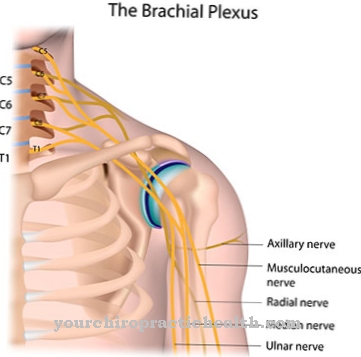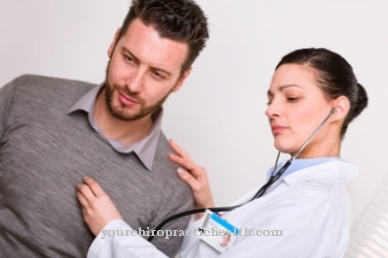Numerous people suffer from one Wasp venom allergyby showing violent reactions to a simple wasp sting. What exactly is a wasp venom allergy? What are their causes? And how can a wasp venom allergy be treated successfully?
What is a wasp venom allergy?
A Wasp venom allergy is an allergic reaction to a wasp sting that can be life-threatening. Normally, a wasp sting causes short-term pain, the sting spot turns red and swells slightly.
However, people who suffer from wasp venom allergy are much more sensitive. They have rashes, sweats, dizziness, nausea and palpitations as a result of the sting. In the worst case, anaphylactic shock occurs, which can lead to respiratory failure. A wasp venom allergy is often only diagnosed after the second sting.
If a child or an adult shows severe symptoms after a wasp sting, a doctor should always be consulted to take therapeutic measures against the wasp venom allergy.
causes
The trigger of the Wasp venom allergy is the poison of the wasp. This poison contains certain proteins against which people who suffer from wasp venom allergy form special antibodies.
This already happens after the first wasp sting. However, an allergic reaction of the body does not occur until after the second bite. The renewed contact with the poison triggers a strong immune reaction and hypersensitivity, which are shown in the symptoms typical of wasp venom allergy.
The patient sweats profusely, feels dizzy and nauseous, his heart is racing and the skin also reacts by developing a rash. This exaggerated defense reaction is triggered by the body's own messenger substance histamine, which is released in far too large quantities as a result of the wasp venom allergy.
Symptoms, ailments & signs
The symptoms that show up after a wasp sting can vary greatly, depending on how severe the allergy is in a patient. After a wasp's sting, local skin reactions usually occur first. Edema usually forms at the puncture site, which leads to swelling of the skin. The swelling is almost always accompanied by reddening of the skin and itching.
The itching can take on proportions that are extremely stressful for the patient. The constant scratching usually increases the two primary symptoms, i.e. the swelling and the reddening of the skin. However, these side effects occur in many people after a wasp sting and therefore do not yet indicate an allergy to the wasp venom.
Other symptoms occur in sensitive patients. Burning pain often occurs in the area of the puncture site. In allergy sufferers, nausea and vomiting often develop after the bite. However, a patient is only at risk of fatality when symptoms appear that indicate a severe allergy.
These include in particular shortness of breath, dizziness and acute anxiety states. These symptoms are often the first sign of anaphylactic shock. In this case, a circulatory collapse must be expected, which can lead to the death of the patient.
Diagnosis & course
Becomes a person who is under a Wasp venom allergy suffers from being stung by a wasp, the swelling is much larger than would normally be the case. In a wasp venom allergy, the swelling is about ten centimeters in diameter and does not subside after a few hours, but sometimes lasts for a day or two.
If these symptoms persist, one speaks of a slight wasp venom allergy. A moderate wasp venom allergy causes reddening of the skin and the formation of wheals, swelling of the eyelids and lips and gastrointestinal cramps, which often lead to diarrhea and vomiting. In this case, a doctor should be consulted. A severe wasp venom allergy occurs when there are severe respiratory and circulatory problems, shortness of breath and palpitations, and the patient's blood pressure drops rapidly.
This situation can be life-threatening, as so-called anaphylactic shock is possible, which can lead to unconsciousness or even cardiac arrest. Immediate help from an emergency doctor is required here. If no wasp venom allergy has been previously diagnosed with any of these three types of reactions, it is important that the following questions are answered for an accurate diagnosis.
Does the sting actually come from a wasp or is a bee or a hornet also an option? How much time has passed after the bite before the allergic reaction became apparent? How exactly were the complaints expressed? Is this the first time such a reaction has occurred after a wasp sting? In order to clearly confirm the diagnosis of wasp venom allergy, additional skin tests and, if necessary, a blood test are carried out in the clinic or by the doctor.
Complications
A wasp venom allergy leads to complications above all if the person concerned not only reacts difficultly locally to the sting, but the wasp sting affects the entire body. The most serious complication associated with wasp venom allergy is possible anaphylactic shock. It effectively leads to circulatory failure and organ failure and, without emergency medical care, means the death of the person concerned.
Anaphylactic shock can be treated in hospital, but sequelae are possible. A very slight wasp venom allergy, which manifests itself primarily in the development of a large swelling, does not lead to any complications. The swelling heals after a few days at the latest.
A moderate form of wasp venom allergy, in which severe pain, wheals, swelling of the face or stomach and intestinal problems occur, can lead to complications if the reactions are very severe. This means the need for treatment. The puncture site is particularly relevant: the mouth area is much more vulnerable than, for example, the thigh.
Furthermore, the symptoms of an allergic reaction themselves can lead to complications - for example in the form of falls as a result of fainting, or scratched and inflamed areas of the skin due to itchy redness.
When should you go to the doctor?
If swelling occurs after a wasp bite, an attempt should be made to remove the poison injected from the insect bite under the skin. Vacuuming the wound can help minimize pain or swelling. In addition, the region must be cooled so that the symptoms can be alleviated. If the person concerned experiences an improvement in their health within the next hour, no doctor is required.
Consultation with a doctor, however, should be initiated as soon as possible if the patient's state of health has deteriorated significantly within a few minutes. If there is severe swelling due to the insect bite, acute discomfort and changes in the skin, this is considered worrying. If breathing is impaired, there is an acute need for action. In the event of breathlessness, an ambulance service must be alerted. In addition, first aid measures are to be provided by those present.
Disorders of the heart rhythm, sweating and convulsions indicate an allergic reaction. Go to the nearest hospital immediately. Itching, reddening of the skin, nausea, dizziness, and vomiting are other signs for which a doctor should be called for help. Since anaphylactic shock can occur in particularly severe cases, a wasp sting must respond comprehensively as quickly as possible. Otherwise, there is a risk of premature death.
Treatment & Therapy
Patients who know they are under a Wasp venom allergy should always carry an emergency kit with them, especially in late summer. Such a set contains a certain antihistamine, as well as cortisone and adrenaline.
If, despite great caution, which people with wasp venom allergy should always exercise, a sting does occur, this emergency set is suitable for first aid measures. One therapy option for wasp venom allergy is desensitization. The body gradually gets used to the wasp venom by repeatedly confronting it with small, increasing amounts of the venom during the treatment period. This creates immunity to wasp venom.
Desensitization has proven to be a successful therapy and works for almost every patient who suffers from wasp venom allergy. The duration of treatment extends over three to five years, but is usually concluded with the result that the patient is completely cured of the wasp venom allergy. In addition, there is the possibility of a quick desensitization, which only takes a few weeks.
This method is only recommended in the case of a particularly high allergy risk, as the therapy itself is associated with an increased risk, which makes it necessary to stay in hospital during the treatment period. Fast desensitization also frees almost everyone affected from their wasp venom allergy.
prevention
When you know a Wasp venom allergy is present and the therapy has not yet been completed, it is important to avoid the wasps as much as possible.
Wasps are particularly active in late summer, so allergy sufferers should be very careful when eating and drinking outdoors at this time, as wasps are primarily attracted to sweet drinks and grilled meat. Overfilled litter bins, for example at rest areas or in swimming pools, should be avoided as much as wasps are particularly fond of lingering here. If you want to keep a wasp away, lemon wedges peppered with cloves are a tried and tested home remedy.
Wasps find this smell repulsive. In order to be protected from possible stings in the house, we recommend that people who suffer from wasp venom allergy attach insect nets to the windows in summer.
Aftercare
In the case of wasp venom allergy, those affected usually only have very limited measures or options for follow-up care available. The disease itself cannot be completely cured and is usually congenital. A wasp sting should therefore be avoided as far as possible so that there are no complications or other complaints for the person concerned.
If there is a sting, action must be taken quickly. The person affected has to take some medication that can alleviate and limit the symptoms. All doctor's instructions must be observed in order to prevent side effects. In some cases, wasp venom allergy can also be relieved. It is also recommended that the person affected always has an emergency kit with them so that they can immediately take care of themselves in the event of a sting.
If such a set is not available, an emergency doctor should be called immediately or the hospital should be visited. Wasp venom allergy does not usually reduce the life expectancy of those affected if a possible sting is treated immediately. In summer, eating and drinking outdoors should be avoided in order not to attract the wasps. Further follow-up measures are not available to those affected with wasp venom allergy.
You can do that yourself
Basically, it is important to avoid the wasps as much as possible. Since wasps are particularly active in late summer, allergy sufferers should be very careful when eating and drinking outside during this time - wasps are particularly attracted to sweet drinks and grilled meat. You should also avoid overcrowded litter bins, such as those found at rest areas or in swimming pools.
In order to keep wasps away in a targeted manner, a tried and tested home remedy should be used - lemon wedges that are peppered with cloves. Wasps find this odor repulsive. In order to be adequately protected in the house, it is advisable for people who suffer from wasp venom allergy to attach insect nets to the windows during the warm season.
People who are known to have a wasp sting allergy should not leave the house without an emergency kit, especially in late summer. Such a set contains not only a specific antihistamine, but also cortisone and adrenaline. If a wasp sting occurs despite absolute caution, this emergency kit should be used and sufficient for initial relief measures. It is of course important that those affected familiarize themselves with the medication beforehand so that they can use them immediately in an emergency.

.jpg)
.jpg)



.jpg)




















